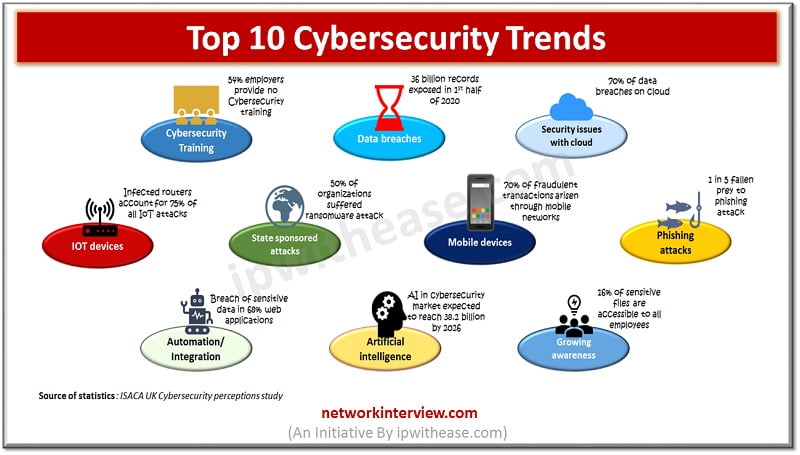Trends cybersecurity networkinterview
Six trends in cybersecurity which you should be aware of (infographic)
Safeguard Your Digital Fortress with these Cybersecurity Trends

In an increasingly interconnected world, the need to protect our digital fortresses has become more critical than ever. Cybersecurity, which encompasses a range of practices and measures aimed at safeguarding our digital assets, has evolved rapidly in recent years. Here, we outline six essential trends that everyone, regardless of background or industry, should be aware of.
1. AI-Powered Cybersecurity: Artificial Intelligence (AI) is at the forefront of the cybersecurity battle. It enables advanced threat detection and response capabilities, as well as the automation of security operations. With the ability to analyze vast amounts of data in real-time, AI is revolutionizing the fight against cyber threats.
2. Zero Trust Architecture: Gone are the days when perimeter security alone could protect our systems. Zero Trust Architecture operates under the assumption that no user or device should be trusted by default, regardless of location or network. This approach prioritizes strict authentication and continuous monitoring to mitigate the risks associated with insider threats and compromised credentials.
3. Cloud Security: As more businesses adopt cloud computing, ensuring the security of cloud-based infrastructure has become crucial. Cloud security practices involve robust data encryption, strong access controls, and regular monitoring to protect against unauthorized access and data breaches.
4. Incident Response Automation: Rapid response is key to minimizing the impact of cyber incidents. Incident response automation utilizes AI and machine learning to detect, analyze, and respond to security events in real-time. By automating routine tasks, organizations can effectively reduce response times and free up valuable resources for proactive security measures.
5. Biometric Authentication: Traditional password-based authentication is increasingly vulnerable to hacking and phishing attacks. Biometric authentication methods, such as fingerprint, facial, or iris recognition, offer a more secure alternative. These technologies rely on unique physical characteristics to verify user identities, significantly reducing the risk of unauthorized access.
6. IoT Security: With the rise of Internet of Things (IoT) devices, ensuring their security has become imperative. IoT security involves secure device authentication, encryption of data transmission, and regular firmware updates to protect against potential vulnerabilities and unauthorized access.
Top 10 Cybersecurity trends for 2022
Stay Ahead of the Game with these Cybersecurity Trends

In today's ever-evolving digital landscape, staying informed about the latest cybersecurity trends is vital. As cyber threats continue to multiply, individuals and organizations must remain one step ahead. Here are the top ten trends that will shape the cybersecurity landscape in 2022.
1. Ransomware Resilience: Ransomware attacks are becoming more sophisticated, targeting both individuals and organizations. To combat this, developing robust ransomware resilience strategies, including regular backups and employee training, is essential.
2. Quantum Computing and Cybersecurity: Quantum computers have the potential to break traditional encryption methods. As quantum computing progresses, cybersecurity experts are developing post-quantum encryption algorithms to protect sensitive data from future threats.
3. Internet of Behaviors (IoB): IoB refers to the collection of individual behavioral data through various technologies. While it offers opportunities for personalized experiences, ensuring data privacy and security is vital to avoid misuse and potential data breaches.
4. Supply Chain Attacks: Cybercriminals increasingly target software supply chains, aiming to inject malware into otherwise trusted applications. Implementing stringent software development practices, including code reviews and vulnerability assessments, will be crucial in mitigating these attacks.
5. Increased Emphasis on Employee Training: Humans remain one of the weakest links in cybersecurity. Organizations will focus on comprehensive security awareness training programs to educate employees about potential threats and best practices for safeguarding information.
6. Data Privacy: As concerns over data privacy continue to grow, regulatory bodies are implementing stricter laws and guidelines. Organizations must prioritize complying with data protection regulations to build trust with customers and avoid legal consequences.
7. DevSecOps Integration: DevSecOps strives to integrate security practices throughout the software development lifecycle. By embedding security measures early on, organizations can proactively identify and address vulnerabilities, reducing the risk of future cyber attacks.
8. Cyber Threat Intelligence: Cyber threat intelligence involves collecting and analyzing data on potential and existing threats. Organizations will invest in intelligence tools and platforms to stay informed about emerging threats and take proactive measures to protect their digital assets.
9. Biometrics in Authentication: Biometric authentication methods, such as fingerprint and facial recognition, will continue to gain popularity due to their effectiveness and convenience. Implementing multi-factor authentication techniques will enhance overall security.
10. Cyber Insurance: As cyber threats become more prevalent, insurance coverage against potential breaches and resulting damages will become increasingly common. Organizations will rely on cyber insurance policies to mitigate financial losses and accelerate recovery in case of an attack.
By remaining informed about these cybersecurity trends, individuals and organizations can better defend themselves against the ever-evolving landscape of cyber threats. Remember to implement robust security measures, keep software up to date, and educate yourself and others on best practices for a safer digital future.